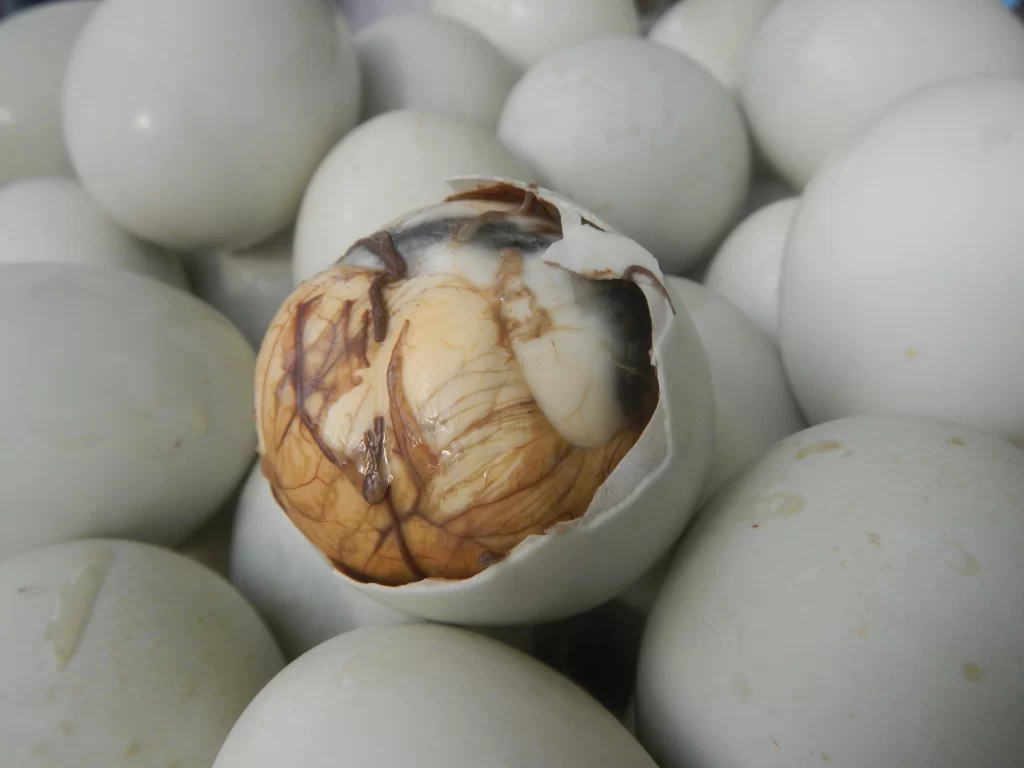In the lively streets of the Philippines, as evening settles in, a familiar call rings out: “Balut! Balut!” Vendors selling this iconic snack wander through neighbourhoods, balancing baskets of warm fertilised duck eggs. For many Filipinos, this is more than just a snack; it’s a piece of home. And for those daring enough to try it, eating balut is an unforgettable experience.
Balut is no ordinary egg. It’s a fertilised duck embryo, incubated for about 14 to 21 days, which gives it a unique character. By the time it’s ready, the embryo has partially developed, with tiny wings, a beak, and, sometimes, soft feathers. For Filipinos, this dish is packed with flavour and tradition, but for outsiders, it can feel like a shocking challenge. Still, for those willing to give it a go, balut promises a taste adventure unlike any other.
From Crack to Sip: How to Eat Balut
Eating balut has a specific ritual, starting with choosing just the right egg. Street vendors often recommend picking one with a warm shell. First, you gently crack the rounded end of the egg, creating a small opening. Inside, there’s a savoury broth, which fans of balut compare to rich chicken soup. Many like to season the broth with a pinch of salt, vinegar, or even chilli, giving it an extra kick.
Once the broth is gone, it’s time to peel back the shell, revealing the yolk and the tiny embryo inside. The yolk is creamy and smooth, with a texture that some describe as pudding-like. The embryo, meanwhile, can be tender, though it might reveal delicate features that can make some first-timers hesitate. Balut eaters usually say that it’s best enjoyed with an open mind and a willingness to embrace the experience fully.
The “Worst-Rated” Dish Loved by Millions
Despite being a beloved Filipino delicacy, balut recently gained an unusual title: the “worst-rated Filipino food.” TasteAtlas, a global culinary site, awarded it this rank after gathering ratings from over 3,800 people. The score? A mere 2.7 out of 5. Yet, Filipinos across the world would beg to differ. They see balut as a symbol of cultural pride and resilience, embodying the bold flavours and adventurous spirit of Filipino food. It’s sold everywhere from street stalls to high-end restaurants, often enjoyed with a cold beer on the side, and seasoned with vinegar, garlic, or chilli.
It’s true, though, that balut has an unusual charm. Even celebrities have taken up the challenge. Hollywood actor Zac Efron once tried balut on a talk show, turning the unusual snack into a light-hearted spectacle. Rapper Doja Cat, on the other hand, faced backlash after mistakenly describing it as “a bird that’s eaten alive.” In reality, balut is carefully boiled to achieve the right consistency, with no harm to any living creature.

A Taste of History and Tradition
Balut may be strange to outsiders, but it’s a dish with a long history. Many believe it was first introduced by Chinese traders hundreds of years ago. Its preparation style shares similarities with century eggs, another Chinese delicacy. Since then, it’s become woven into Filipino culture, with festivals in places like Pateros, the so-called “Balut Capital” of the Philippines, celebrating this dish yearly.
For Filipinos, eating balut is not just about the taste; it’s about connecting with family and sharing an experience that goes back generations. Many people who move overseas say they look forward to eating balut when they visit home. The dish may even be found at Filipino grocery stores abroad, offering a taste of home for those feeling a bit nostalgic.
The Health Benefits Hidden in the Egg
Balut may look a little confronting, but it’s packed with nutrients. Each egg contains vitamins like C, beta-carotene, niacin, riboflavin, and thiamine. With only 188 calories, it offers 14 grams of protein and is rich in calcium, iron, and phosphorus. Some believe balut has health benefits in the Philippines, making it popular among pregnant women who feel it boosts their strength and energy. Others consider it an aphrodisiac, adding a dash of mystery to the dish’s appeal.
In recent years, fewer young Filipinos eat balut. Fast food has risen in popularity, and traditional balut vendors face competition from modern convenience. Despite this, balut hasn’t disappeared; it remains part of the Philippines’ culinary landscape. Similar dishes are enjoyed in nearby countries like Vietnam and Cambodia, though with slightly different flavours and textures. For many, balut is a reminder of home, family gatherings, and a love for food that goes beyond taste.



























































